Comprehensive Business Research Report: Cross-Cultural Team Management
VerifiedAdded on 2019/10/30
|13
|2143
|515
Report
AI Summary
This business research report addresses the challenges of managing cross-cultural teams in a global context. The report begins with an introduction outlining the issues faced by global teams, such as time zone differences, cultural disparities, and limited face-to-face interaction. The project objectives aim to identify ways to smoothly manage these teams, while the scope focuses on practical solutions within multinational workplaces. A literature review explores existing research on cross-cultural team management, highlighting issues like power dynamics, cultural stereotypes, and communication barriers. The research employs a mixed-methods approach, combining qualitative and quantitative research methods to collect data through literature reviews, online sources, surveys, and interviews with employees and managers from multinational companies. The report outlines the research design, data collection methods, target participants, sample size, research location, and resources used. Data analysis will be performed using Microsoft Excel, with ethical considerations ensuring voluntary participation and confidentiality. The report acknowledges potential limitations, such as data reliability and manager availability. Finally, the report concludes with a summary of the findings and recommendations for improving cross-cultural team management, emphasizing the importance of creating a sense of belonging and fostering team cohesion.
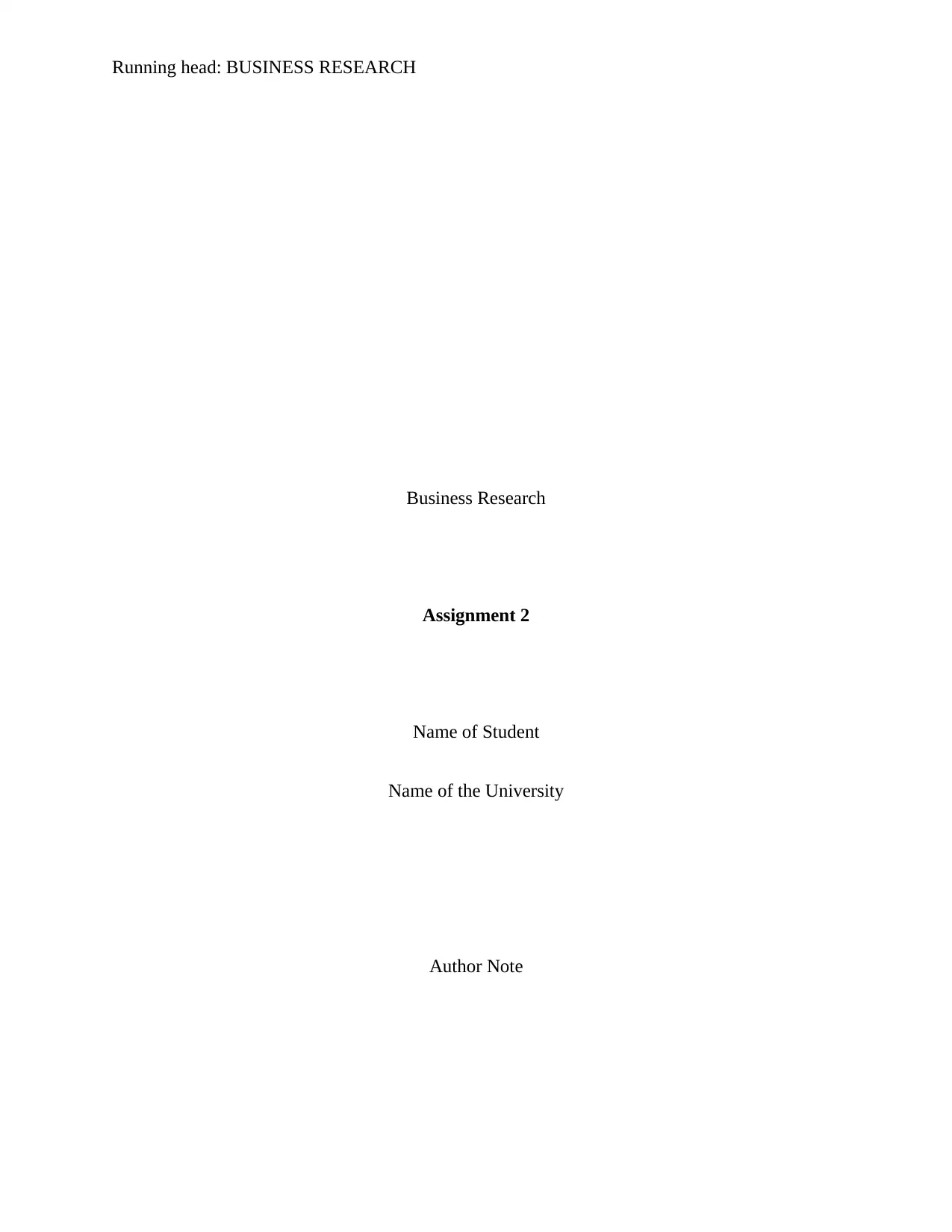
Running head: BUSINESS RESEARCH
Business Research
Assignment 2
Name of Student
Name of the University
Author Note
Business Research
Assignment 2
Name of Student
Name of the University
Author Note
Paraphrase This Document
Need a fresh take? Get an instant paraphrase of this document with our AI Paraphraser
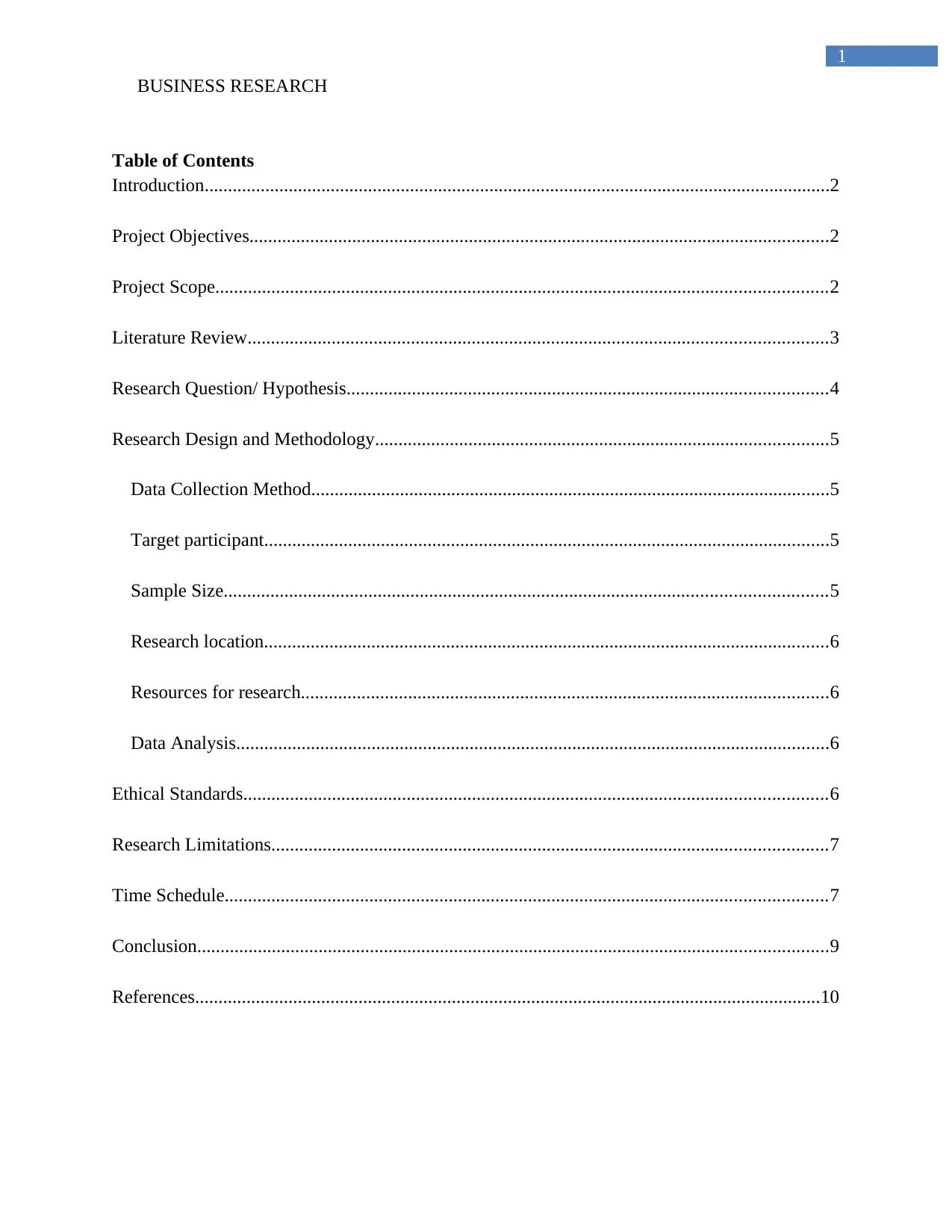
1
BUSINESS RESEARCH
Table of Contents
Introduction......................................................................................................................................2
Project Objectives............................................................................................................................2
Project Scope...................................................................................................................................2
Literature Review............................................................................................................................3
Research Question/ Hypothesis.......................................................................................................4
Research Design and Methodology.................................................................................................5
Data Collection Method...............................................................................................................5
Target participant.........................................................................................................................5
Sample Size.................................................................................................................................5
Research location.........................................................................................................................6
Resources for research.................................................................................................................6
Data Analysis...............................................................................................................................6
Ethical Standards.............................................................................................................................6
Research Limitations.......................................................................................................................7
Time Schedule.................................................................................................................................7
Conclusion.......................................................................................................................................9
References......................................................................................................................................10
BUSINESS RESEARCH
Table of Contents
Introduction......................................................................................................................................2
Project Objectives............................................................................................................................2
Project Scope...................................................................................................................................2
Literature Review............................................................................................................................3
Research Question/ Hypothesis.......................................................................................................4
Research Design and Methodology.................................................................................................5
Data Collection Method...............................................................................................................5
Target participant.........................................................................................................................5
Sample Size.................................................................................................................................5
Research location.........................................................................................................................6
Resources for research.................................................................................................................6
Data Analysis...............................................................................................................................6
Ethical Standards.............................................................................................................................6
Research Limitations.......................................................................................................................7
Time Schedule.................................................................................................................................7
Conclusion.......................................................................................................................................9
References......................................................................................................................................10
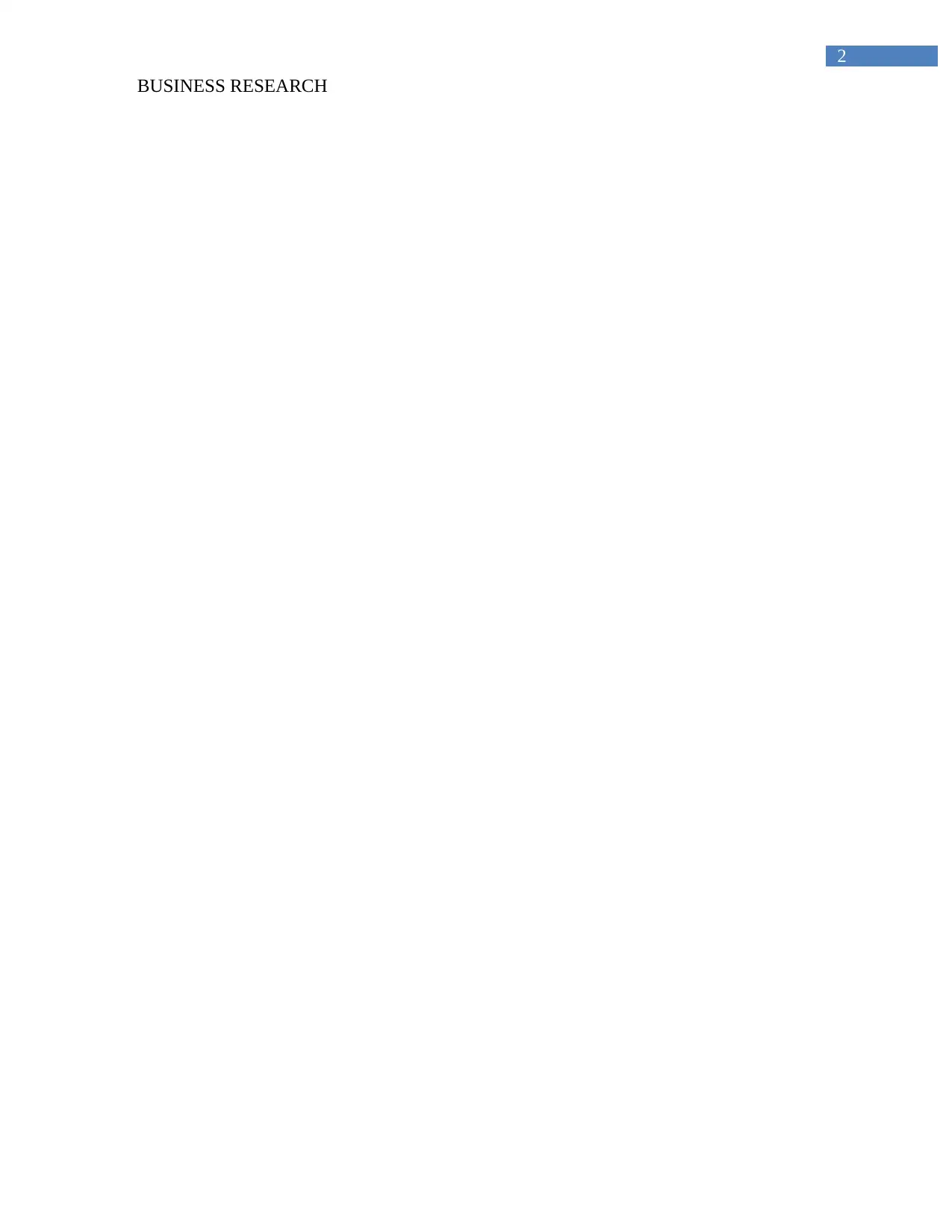
2
BUSINESS RESEARCH
BUSINESS RESEARCH
⊘ This is a preview!⊘
Do you want full access?
Subscribe today to unlock all pages.

Trusted by 1+ million students worldwide
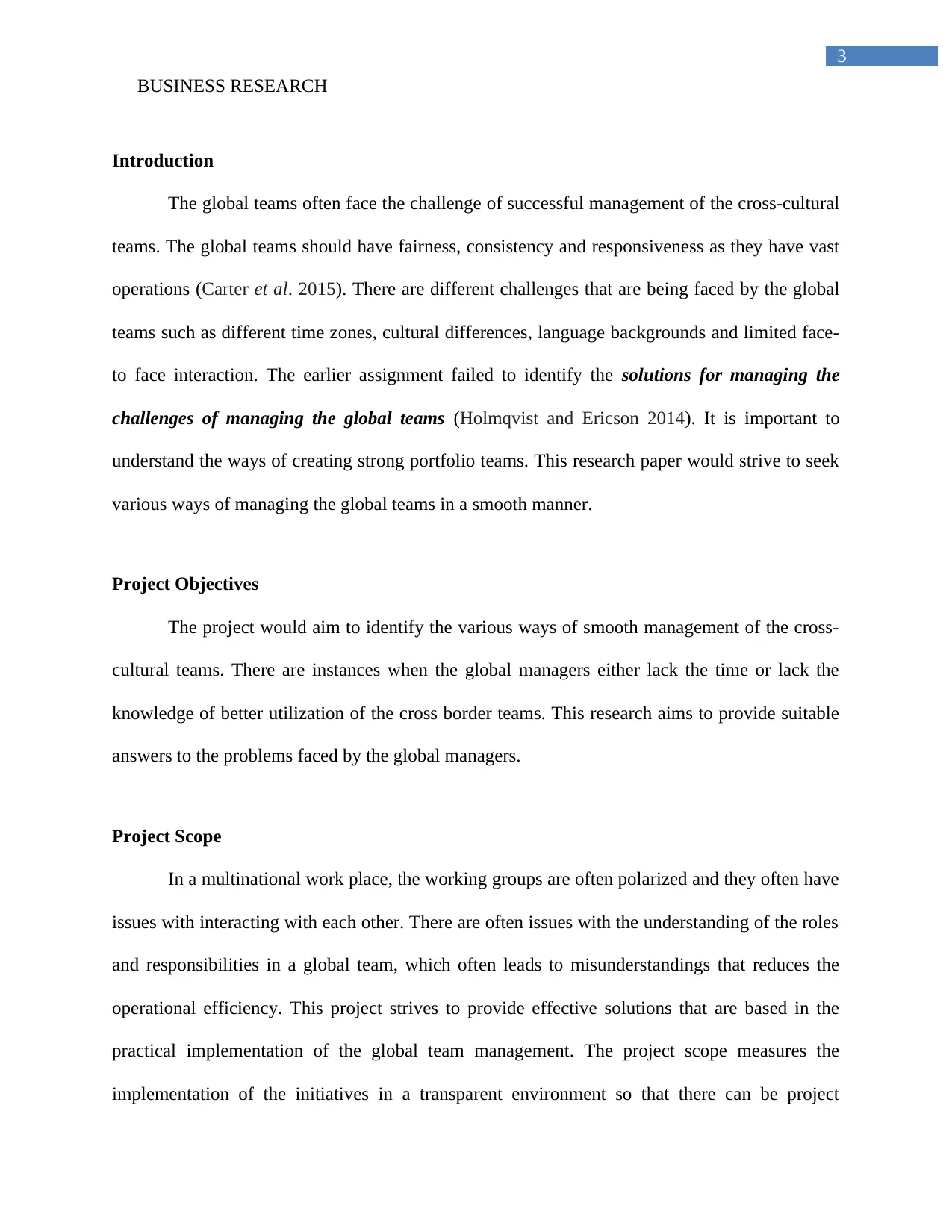
3
BUSINESS RESEARCH
Introduction
The global teams often face the challenge of successful management of the cross-cultural
teams. The global teams should have fairness, consistency and responsiveness as they have vast
operations (Carter et al. 2015). There are different challenges that are being faced by the global
teams such as different time zones, cultural differences, language backgrounds and limited face-
to face interaction. The earlier assignment failed to identify the solutions for managing the
challenges of managing the global teams (Holmqvist and Ericson 2014). It is important to
understand the ways of creating strong portfolio teams. This research paper would strive to seek
various ways of managing the global teams in a smooth manner.
Project Objectives
The project would aim to identify the various ways of smooth management of the cross-
cultural teams. There are instances when the global managers either lack the time or lack the
knowledge of better utilization of the cross border teams. This research aims to provide suitable
answers to the problems faced by the global managers.
Project Scope
In a multinational work place, the working groups are often polarized and they often have
issues with interacting with each other. There are often issues with the understanding of the roles
and responsibilities in a global team, which often leads to misunderstandings that reduces the
operational efficiency. This project strives to provide effective solutions that are based in the
practical implementation of the global team management. The project scope measures the
implementation of the initiatives in a transparent environment so that there can be project
BUSINESS RESEARCH
Introduction
The global teams often face the challenge of successful management of the cross-cultural
teams. The global teams should have fairness, consistency and responsiveness as they have vast
operations (Carter et al. 2015). There are different challenges that are being faced by the global
teams such as different time zones, cultural differences, language backgrounds and limited face-
to face interaction. The earlier assignment failed to identify the solutions for managing the
challenges of managing the global teams (Holmqvist and Ericson 2014). It is important to
understand the ways of creating strong portfolio teams. This research paper would strive to seek
various ways of managing the global teams in a smooth manner.
Project Objectives
The project would aim to identify the various ways of smooth management of the cross-
cultural teams. There are instances when the global managers either lack the time or lack the
knowledge of better utilization of the cross border teams. This research aims to provide suitable
answers to the problems faced by the global managers.
Project Scope
In a multinational work place, the working groups are often polarized and they often have
issues with interacting with each other. There are often issues with the understanding of the roles
and responsibilities in a global team, which often leads to misunderstandings that reduces the
operational efficiency. This project strives to provide effective solutions that are based in the
practical implementation of the global team management. The project scope measures the
implementation of the initiatives in a transparent environment so that there can be project
Paraphrase This Document
Need a fresh take? Get an instant paraphrase of this document with our AI Paraphraser
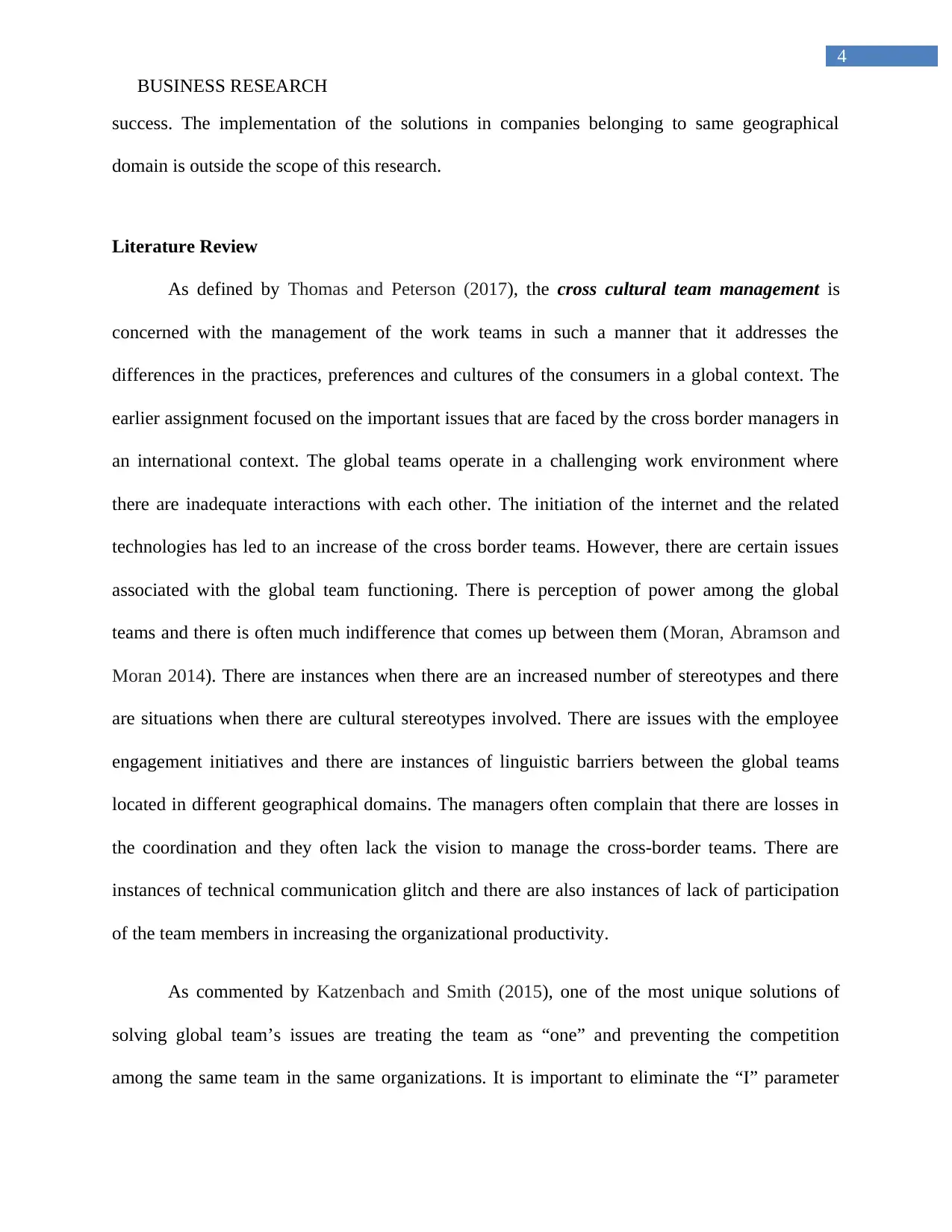
4
BUSINESS RESEARCH
success. The implementation of the solutions in companies belonging to same geographical
domain is outside the scope of this research.
Literature Review
As defined by Thomas and Peterson (2017), the cross cultural team management is
concerned with the management of the work teams in such a manner that it addresses the
differences in the practices, preferences and cultures of the consumers in a global context. The
earlier assignment focused on the important issues that are faced by the cross border managers in
an international context. The global teams operate in a challenging work environment where
there are inadequate interactions with each other. The initiation of the internet and the related
technologies has led to an increase of the cross border teams. However, there are certain issues
associated with the global team functioning. There is perception of power among the global
teams and there is often much indifference that comes up between them (Moran, Abramson and
Moran 2014). There are instances when there are an increased number of stereotypes and there
are situations when there are cultural stereotypes involved. There are issues with the employee
engagement initiatives and there are instances of linguistic barriers between the global teams
located in different geographical domains. The managers often complain that there are losses in
the coordination and they often lack the vision to manage the cross-border teams. There are
instances of technical communication glitch and there are also instances of lack of participation
of the team members in increasing the organizational productivity.
As commented by Katzenbach and Smith (2015), one of the most unique solutions of
solving global team’s issues are treating the team as “one” and preventing the competition
among the same team in the same organizations. It is important to eliminate the “I” parameter
BUSINESS RESEARCH
success. The implementation of the solutions in companies belonging to same geographical
domain is outside the scope of this research.
Literature Review
As defined by Thomas and Peterson (2017), the cross cultural team management is
concerned with the management of the work teams in such a manner that it addresses the
differences in the practices, preferences and cultures of the consumers in a global context. The
earlier assignment focused on the important issues that are faced by the cross border managers in
an international context. The global teams operate in a challenging work environment where
there are inadequate interactions with each other. The initiation of the internet and the related
technologies has led to an increase of the cross border teams. However, there are certain issues
associated with the global team functioning. There is perception of power among the global
teams and there is often much indifference that comes up between them (Moran, Abramson and
Moran 2014). There are instances when there are an increased number of stereotypes and there
are situations when there are cultural stereotypes involved. There are issues with the employee
engagement initiatives and there are instances of linguistic barriers between the global teams
located in different geographical domains. The managers often complain that there are losses in
the coordination and they often lack the vision to manage the cross-border teams. There are
instances of technical communication glitch and there are also instances of lack of participation
of the team members in increasing the organizational productivity.
As commented by Katzenbach and Smith (2015), one of the most unique solutions of
solving global team’s issues are treating the team as “one” and preventing the competition
among the same team in the same organizations. It is important to eliminate the “I” parameter
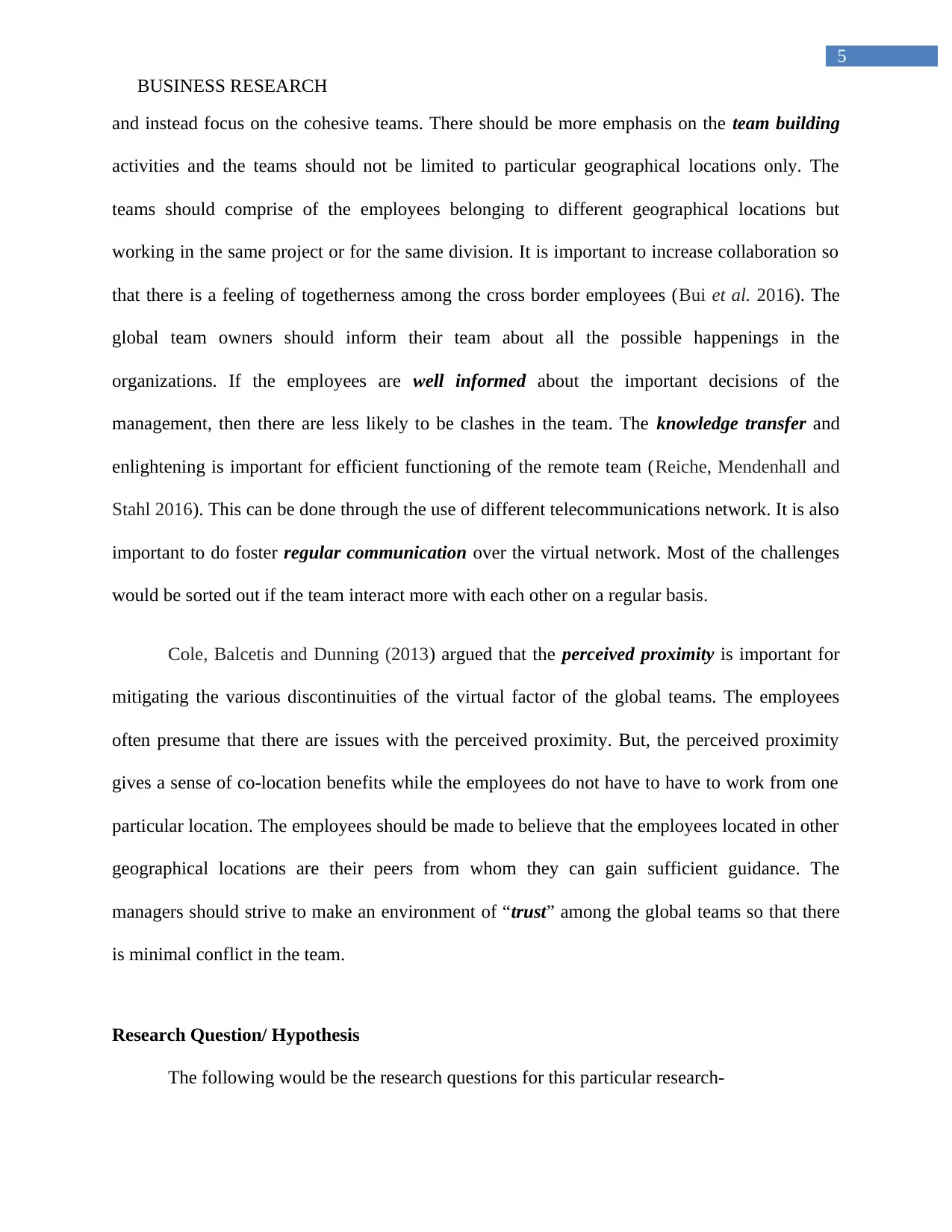
5
BUSINESS RESEARCH
and instead focus on the cohesive teams. There should be more emphasis on the team building
activities and the teams should not be limited to particular geographical locations only. The
teams should comprise of the employees belonging to different geographical locations but
working in the same project or for the same division. It is important to increase collaboration so
that there is a feeling of togetherness among the cross border employees (Bui et al. 2016). The
global team owners should inform their team about all the possible happenings in the
organizations. If the employees are well informed about the important decisions of the
management, then there are less likely to be clashes in the team. The knowledge transfer and
enlightening is important for efficient functioning of the remote team (Reiche, Mendenhall and
Stahl 2016). This can be done through the use of different telecommunications network. It is also
important to do foster regular communication over the virtual network. Most of the challenges
would be sorted out if the team interact more with each other on a regular basis.
Cole, Balcetis and Dunning (2013) argued that the perceived proximity is important for
mitigating the various discontinuities of the virtual factor of the global teams. The employees
often presume that there are issues with the perceived proximity. But, the perceived proximity
gives a sense of co-location benefits while the employees do not have to have to work from one
particular location. The employees should be made to believe that the employees located in other
geographical locations are their peers from whom they can gain sufficient guidance. The
managers should strive to make an environment of “trust” among the global teams so that there
is minimal conflict in the team.
Research Question/ Hypothesis
The following would be the research questions for this particular research-
BUSINESS RESEARCH
and instead focus on the cohesive teams. There should be more emphasis on the team building
activities and the teams should not be limited to particular geographical locations only. The
teams should comprise of the employees belonging to different geographical locations but
working in the same project or for the same division. It is important to increase collaboration so
that there is a feeling of togetherness among the cross border employees (Bui et al. 2016). The
global team owners should inform their team about all the possible happenings in the
organizations. If the employees are well informed about the important decisions of the
management, then there are less likely to be clashes in the team. The knowledge transfer and
enlightening is important for efficient functioning of the remote team (Reiche, Mendenhall and
Stahl 2016). This can be done through the use of different telecommunications network. It is also
important to do foster regular communication over the virtual network. Most of the challenges
would be sorted out if the team interact more with each other on a regular basis.
Cole, Balcetis and Dunning (2013) argued that the perceived proximity is important for
mitigating the various discontinuities of the virtual factor of the global teams. The employees
often presume that there are issues with the perceived proximity. But, the perceived proximity
gives a sense of co-location benefits while the employees do not have to have to work from one
particular location. The employees should be made to believe that the employees located in other
geographical locations are their peers from whom they can gain sufficient guidance. The
managers should strive to make an environment of “trust” among the global teams so that there
is minimal conflict in the team.
Research Question/ Hypothesis
The following would be the research questions for this particular research-
⊘ This is a preview!⊘
Do you want full access?
Subscribe today to unlock all pages.

Trusted by 1+ million students worldwide
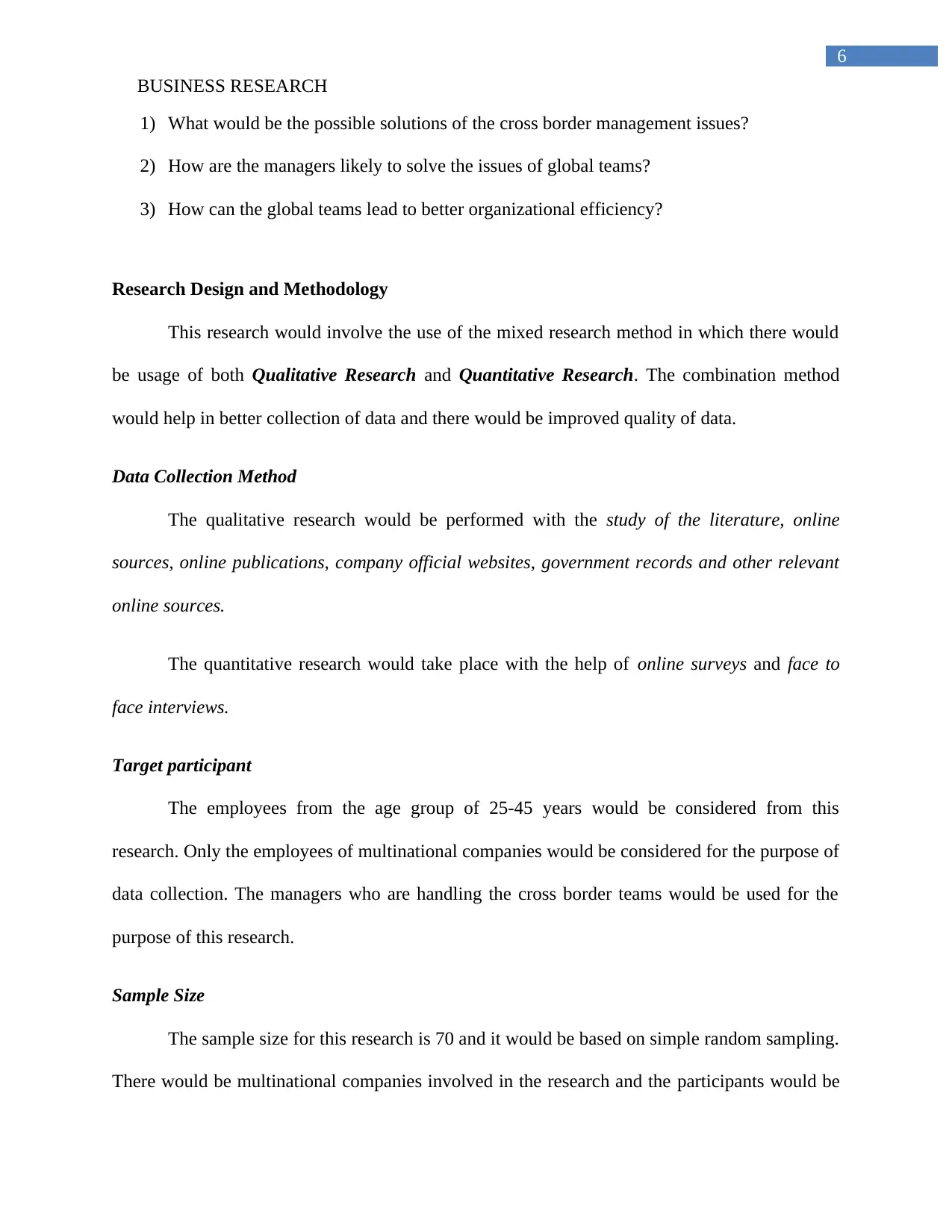
6
BUSINESS RESEARCH
1) What would be the possible solutions of the cross border management issues?
2) How are the managers likely to solve the issues of global teams?
3) How can the global teams lead to better organizational efficiency?
Research Design and Methodology
This research would involve the use of the mixed research method in which there would
be usage of both Qualitative Research and Quantitative Research. The combination method
would help in better collection of data and there would be improved quality of data.
Data Collection Method
The qualitative research would be performed with the study of the literature, online
sources, online publications, company official websites, government records and other relevant
online sources.
The quantitative research would take place with the help of online surveys and face to
face interviews.
Target participant
The employees from the age group of 25-45 years would be considered from this
research. Only the employees of multinational companies would be considered for the purpose of
data collection. The managers who are handling the cross border teams would be used for the
purpose of this research.
Sample Size
The sample size for this research is 70 and it would be based on simple random sampling.
There would be multinational companies involved in the research and the participants would be
BUSINESS RESEARCH
1) What would be the possible solutions of the cross border management issues?
2) How are the managers likely to solve the issues of global teams?
3) How can the global teams lead to better organizational efficiency?
Research Design and Methodology
This research would involve the use of the mixed research method in which there would
be usage of both Qualitative Research and Quantitative Research. The combination method
would help in better collection of data and there would be improved quality of data.
Data Collection Method
The qualitative research would be performed with the study of the literature, online
sources, online publications, company official websites, government records and other relevant
online sources.
The quantitative research would take place with the help of online surveys and face to
face interviews.
Target participant
The employees from the age group of 25-45 years would be considered from this
research. Only the employees of multinational companies would be considered for the purpose of
data collection. The managers who are handling the cross border teams would be used for the
purpose of this research.
Sample Size
The sample size for this research is 70 and it would be based on simple random sampling.
There would be multinational companies involved in the research and the participants would be
Paraphrase This Document
Need a fresh take? Get an instant paraphrase of this document with our AI Paraphraser
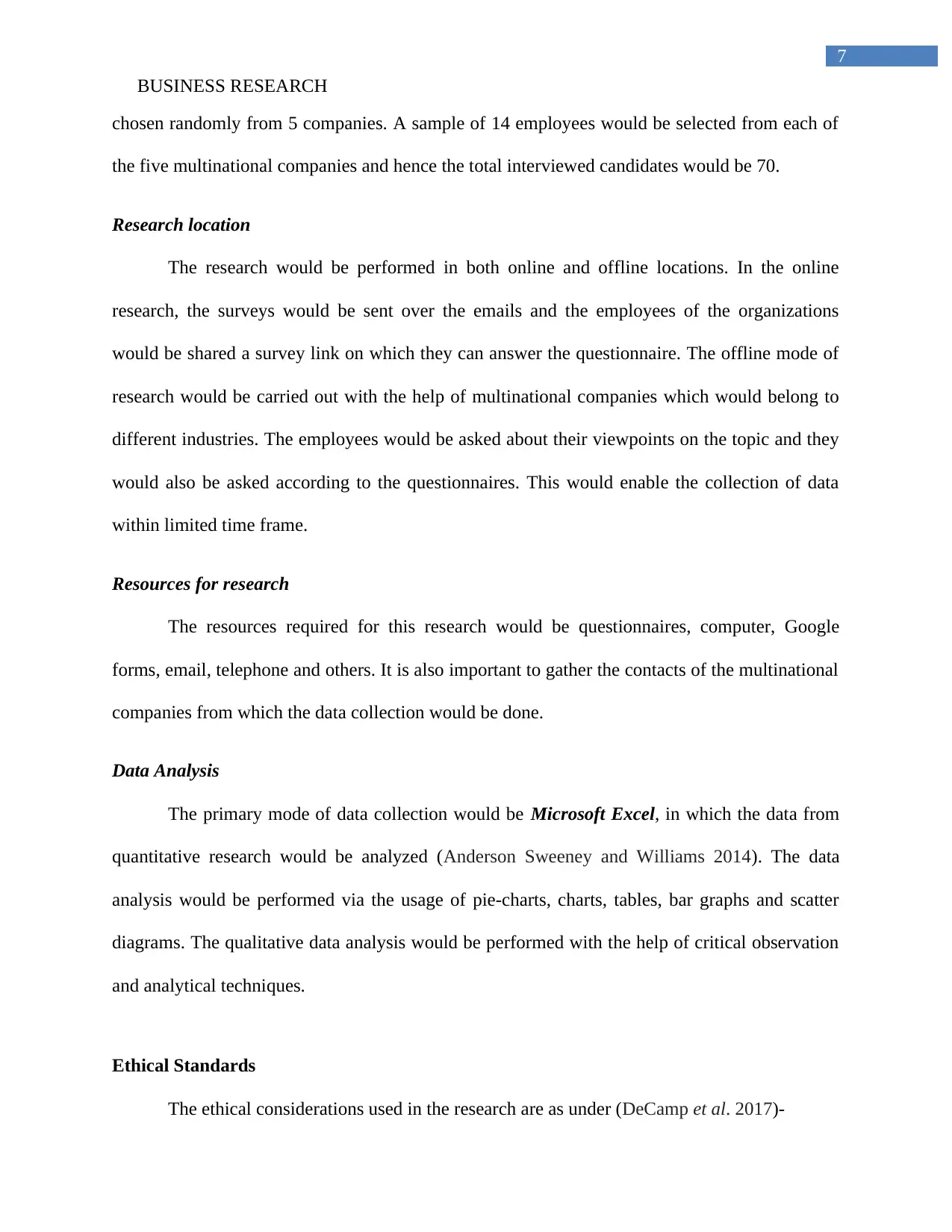
7
BUSINESS RESEARCH
chosen randomly from 5 companies. A sample of 14 employees would be selected from each of
the five multinational companies and hence the total interviewed candidates would be 70.
Research location
The research would be performed in both online and offline locations. In the online
research, the surveys would be sent over the emails and the employees of the organizations
would be shared a survey link on which they can answer the questionnaire. The offline mode of
research would be carried out with the help of multinational companies which would belong to
different industries. The employees would be asked about their viewpoints on the topic and they
would also be asked according to the questionnaires. This would enable the collection of data
within limited time frame.
Resources for research
The resources required for this research would be questionnaires, computer, Google
forms, email, telephone and others. It is also important to gather the contacts of the multinational
companies from which the data collection would be done.
Data Analysis
The primary mode of data collection would be Microsoft Excel, in which the data from
quantitative research would be analyzed (Anderson Sweeney and Williams 2014). The data
analysis would be performed via the usage of pie-charts, charts, tables, bar graphs and scatter
diagrams. The qualitative data analysis would be performed with the help of critical observation
and analytical techniques.
Ethical Standards
The ethical considerations used in the research are as under (DeCamp et al. 2017)-
BUSINESS RESEARCH
chosen randomly from 5 companies. A sample of 14 employees would be selected from each of
the five multinational companies and hence the total interviewed candidates would be 70.
Research location
The research would be performed in both online and offline locations. In the online
research, the surveys would be sent over the emails and the employees of the organizations
would be shared a survey link on which they can answer the questionnaire. The offline mode of
research would be carried out with the help of multinational companies which would belong to
different industries. The employees would be asked about their viewpoints on the topic and they
would also be asked according to the questionnaires. This would enable the collection of data
within limited time frame.
Resources for research
The resources required for this research would be questionnaires, computer, Google
forms, email, telephone and others. It is also important to gather the contacts of the multinational
companies from which the data collection would be done.
Data Analysis
The primary mode of data collection would be Microsoft Excel, in which the data from
quantitative research would be analyzed (Anderson Sweeney and Williams 2014). The data
analysis would be performed via the usage of pie-charts, charts, tables, bar graphs and scatter
diagrams. The qualitative data analysis would be performed with the help of critical observation
and analytical techniques.
Ethical Standards
The ethical considerations used in the research are as under (DeCamp et al. 2017)-
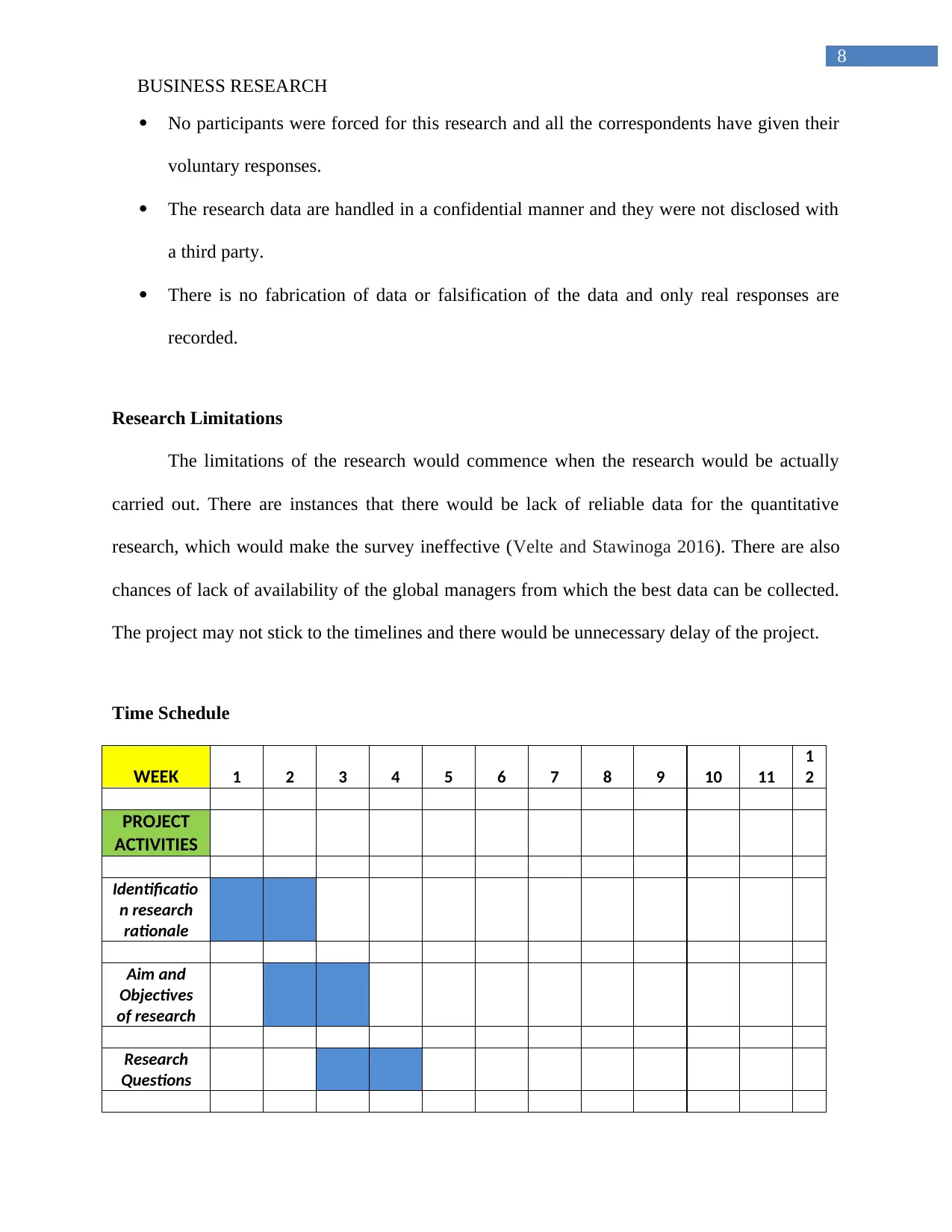
8
BUSINESS RESEARCH
No participants were forced for this research and all the correspondents have given their
voluntary responses.
The research data are handled in a confidential manner and they were not disclosed with
a third party.
There is no fabrication of data or falsification of the data and only real responses are
recorded.
Research Limitations
The limitations of the research would commence when the research would be actually
carried out. There are instances that there would be lack of reliable data for the quantitative
research, which would make the survey ineffective (Velte and Stawinoga 2016). There are also
chances of lack of availability of the global managers from which the best data can be collected.
The project may not stick to the timelines and there would be unnecessary delay of the project.
Time Schedule
WEEK 1 2 3 4 5 6 7 8 9 10 11
1
2
PROJECT
ACTIVITIES
Identificatio
n research
rationale
Aim and
Objectives
of research
Research
Questions
BUSINESS RESEARCH
No participants were forced for this research and all the correspondents have given their
voluntary responses.
The research data are handled in a confidential manner and they were not disclosed with
a third party.
There is no fabrication of data or falsification of the data and only real responses are
recorded.
Research Limitations
The limitations of the research would commence when the research would be actually
carried out. There are instances that there would be lack of reliable data for the quantitative
research, which would make the survey ineffective (Velte and Stawinoga 2016). There are also
chances of lack of availability of the global managers from which the best data can be collected.
The project may not stick to the timelines and there would be unnecessary delay of the project.
Time Schedule
WEEK 1 2 3 4 5 6 7 8 9 10 11
1
2
PROJECT
ACTIVITIES
Identificatio
n research
rationale
Aim and
Objectives
of research
Research
Questions
⊘ This is a preview!⊘
Do you want full access?
Subscribe today to unlock all pages.

Trusted by 1+ million students worldwide
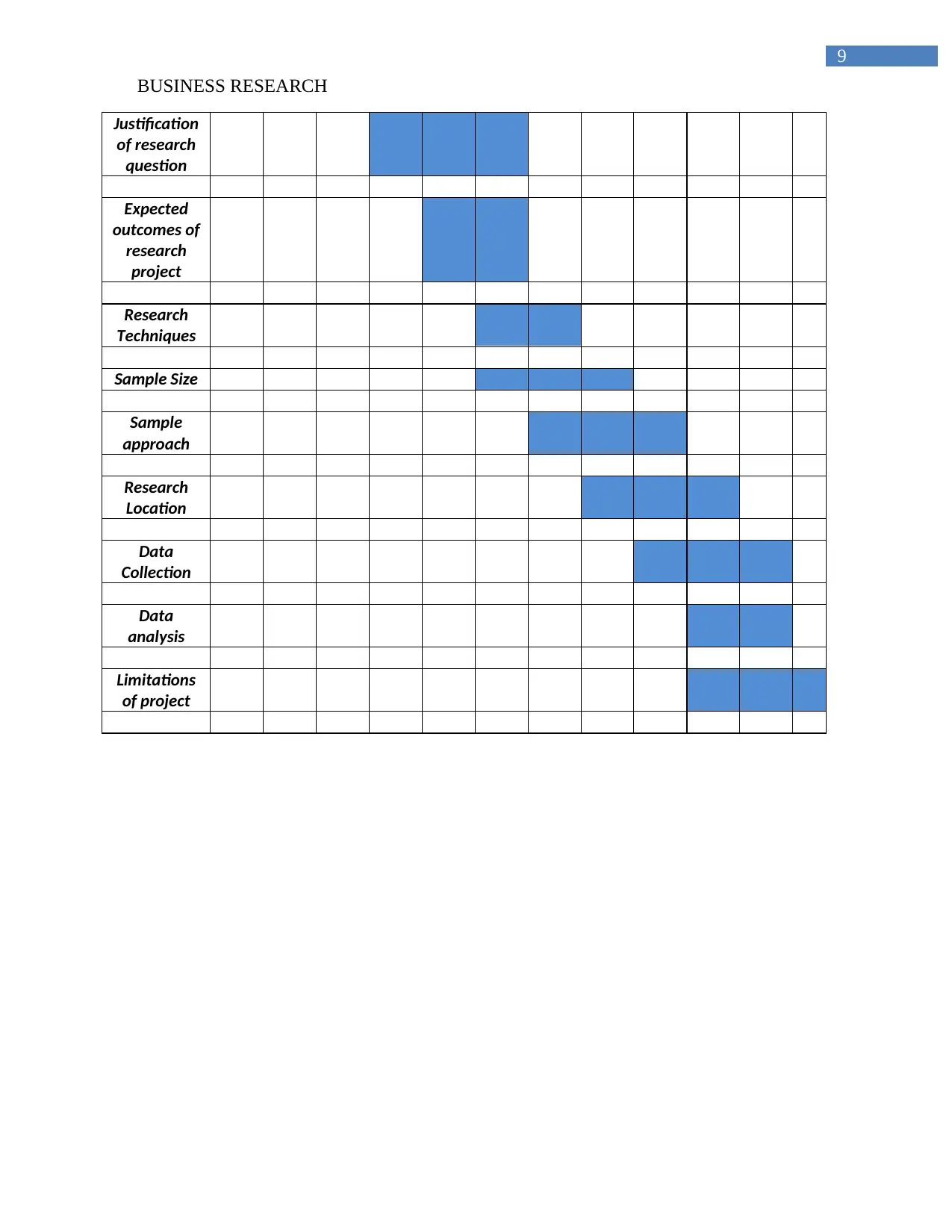
9
BUSINESS RESEARCH
Justification
of research
question
Expected
outcomes of
research
project
Research
Techniques
Sample Size
Sample
approach
Research
Location
Data
Collection
Data
analysis
Limitations
of project
BUSINESS RESEARCH
Justification
of research
question
Expected
outcomes of
research
project
Research
Techniques
Sample Size
Sample
approach
Research
Location
Data
Collection
Data
analysis
Limitations
of project
Paraphrase This Document
Need a fresh take? Get an instant paraphrase of this document with our AI Paraphraser
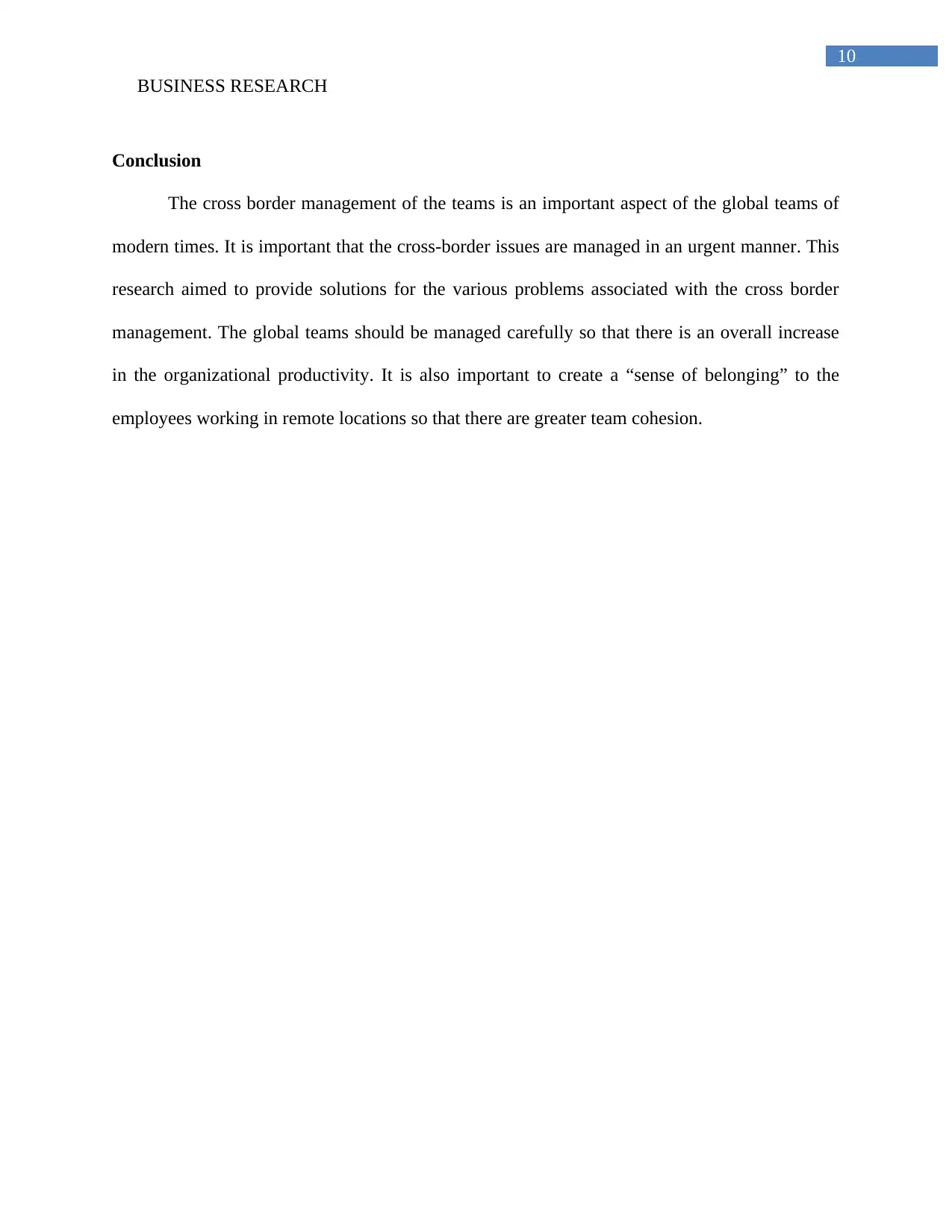
10
BUSINESS RESEARCH
Conclusion
The cross border management of the teams is an important aspect of the global teams of
modern times. It is important that the cross-border issues are managed in an urgent manner. This
research aimed to provide solutions for the various problems associated with the cross border
management. The global teams should be managed carefully so that there is an overall increase
in the organizational productivity. It is also important to create a “sense of belonging” to the
employees working in remote locations so that there are greater team cohesion.
BUSINESS RESEARCH
Conclusion
The cross border management of the teams is an important aspect of the global teams of
modern times. It is important that the cross-border issues are managed in an urgent manner. This
research aimed to provide solutions for the various problems associated with the cross border
management. The global teams should be managed carefully so that there is an overall increase
in the organizational productivity. It is also important to create a “sense of belonging” to the
employees working in remote locations so that there are greater team cohesion.
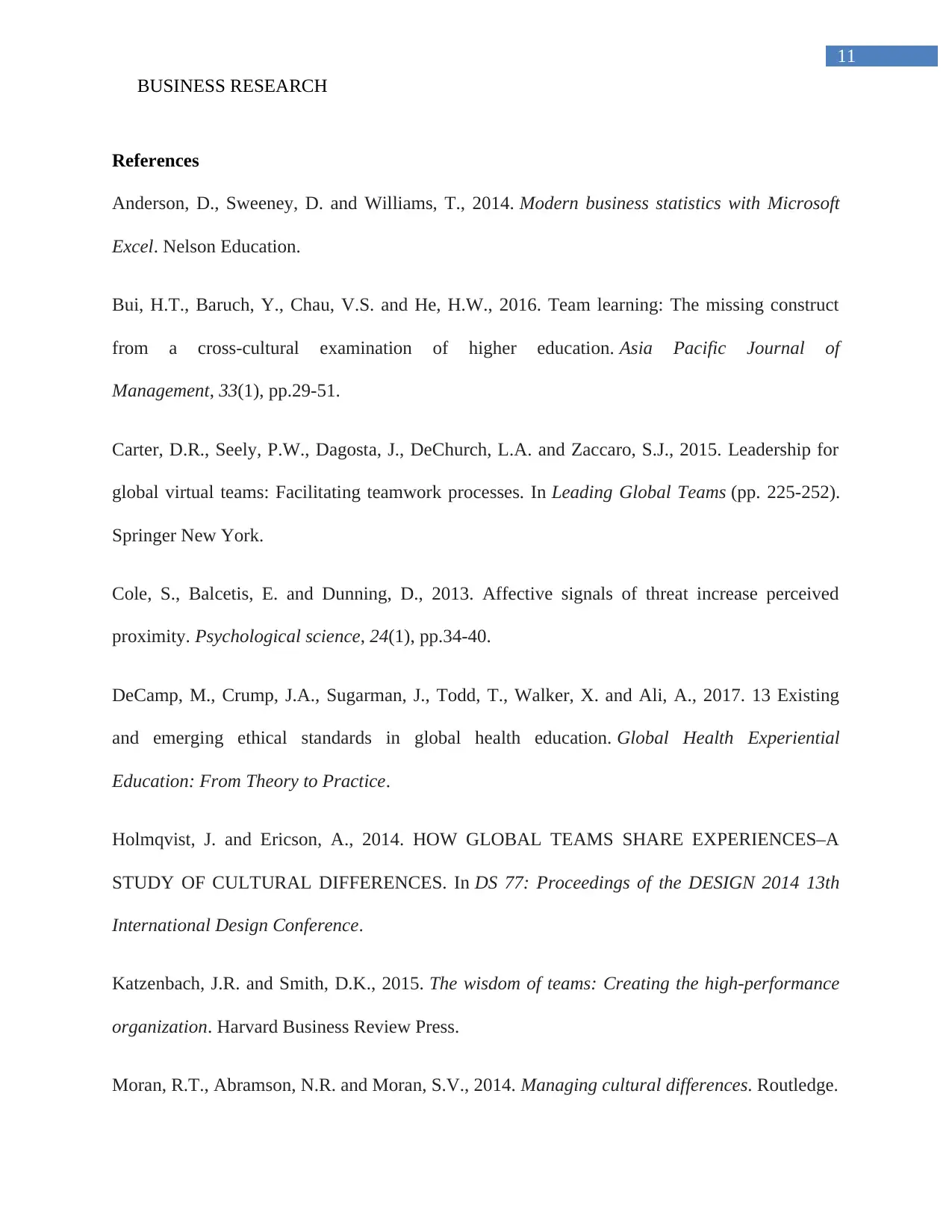
11
BUSINESS RESEARCH
References
Anderson, D., Sweeney, D. and Williams, T., 2014. Modern business statistics with Microsoft
Excel. Nelson Education.
Bui, H.T., Baruch, Y., Chau, V.S. and He, H.W., 2016. Team learning: The missing construct
from a cross-cultural examination of higher education. Asia Pacific Journal of
Management, 33(1), pp.29-51.
Carter, D.R., Seely, P.W., Dagosta, J., DeChurch, L.A. and Zaccaro, S.J., 2015. Leadership for
global virtual teams: Facilitating teamwork processes. In Leading Global Teams (pp. 225-252).
Springer New York.
Cole, S., Balcetis, E. and Dunning, D., 2013. Affective signals of threat increase perceived
proximity. Psychological science, 24(1), pp.34-40.
DeCamp, M., Crump, J.A., Sugarman, J., Todd, T., Walker, X. and Ali, A., 2017. 13 Existing
and emerging ethical standards in global health education. Global Health Experiential
Education: From Theory to Practice.
Holmqvist, J. and Ericson, A., 2014. HOW GLOBAL TEAMS SHARE EXPERIENCES–A
STUDY OF CULTURAL DIFFERENCES. In DS 77: Proceedings of the DESIGN 2014 13th
International Design Conference.
Katzenbach, J.R. and Smith, D.K., 2015. The wisdom of teams: Creating the high-performance
organization. Harvard Business Review Press.
Moran, R.T., Abramson, N.R. and Moran, S.V., 2014. Managing cultural differences. Routledge.
BUSINESS RESEARCH
References
Anderson, D., Sweeney, D. and Williams, T., 2014. Modern business statistics with Microsoft
Excel. Nelson Education.
Bui, H.T., Baruch, Y., Chau, V.S. and He, H.W., 2016. Team learning: The missing construct
from a cross-cultural examination of higher education. Asia Pacific Journal of
Management, 33(1), pp.29-51.
Carter, D.R., Seely, P.W., Dagosta, J., DeChurch, L.A. and Zaccaro, S.J., 2015. Leadership for
global virtual teams: Facilitating teamwork processes. In Leading Global Teams (pp. 225-252).
Springer New York.
Cole, S., Balcetis, E. and Dunning, D., 2013. Affective signals of threat increase perceived
proximity. Psychological science, 24(1), pp.34-40.
DeCamp, M., Crump, J.A., Sugarman, J., Todd, T., Walker, X. and Ali, A., 2017. 13 Existing
and emerging ethical standards in global health education. Global Health Experiential
Education: From Theory to Practice.
Holmqvist, J. and Ericson, A., 2014. HOW GLOBAL TEAMS SHARE EXPERIENCES–A
STUDY OF CULTURAL DIFFERENCES. In DS 77: Proceedings of the DESIGN 2014 13th
International Design Conference.
Katzenbach, J.R. and Smith, D.K., 2015. The wisdom of teams: Creating the high-performance
organization. Harvard Business Review Press.
Moran, R.T., Abramson, N.R. and Moran, S.V., 2014. Managing cultural differences. Routledge.
⊘ This is a preview!⊘
Do you want full access?
Subscribe today to unlock all pages.

Trusted by 1+ million students worldwide
1 out of 13
Related Documents
Your All-in-One AI-Powered Toolkit for Academic Success.
+13062052269
info@desklib.com
Available 24*7 on WhatsApp / Email
![[object Object]](/_next/static/media/star-bottom.7253800d.svg)
Unlock your academic potential
Copyright © 2020–2025 A2Z Services. All Rights Reserved. Developed and managed by ZUCOL.





